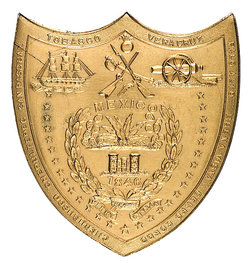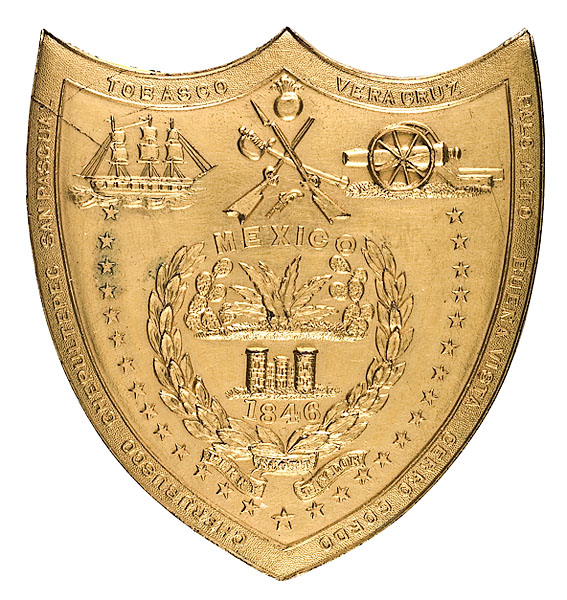Parents John Baptist Shaw Jr, b. 16 Apr 1774, North Carolina d. 28 Jul 1848, North Carolina
Mother Frances "Fannie" Martin High, b. 8 Feb 1782, Wake County North Carolina d. 1 Aug 1848, Wake County North Carolina
Marriage 21 Oct 1841 Wake County North Carolina
Family Martha Ruffin "Patsy" Halliburton, b. 27 Mar 1825, Wake County North Carolina d. 3 Oct 1897, Wake County North Carolina
Miltary ◦Mexican American War; Private First Regiment North Carolina
Died 3 Dec 1847 Saltillo Mexico
Cause: At War
◦Died in the Mexican War from a tropical disease
Children
1. William Henry Shaw, b. 24 Aug 1844, Oak Grove Township Wake County North Carolina d. 18 Dec 1898, Wake County North Carolina
2. John Quincy "Uncle Quince" Shaw, b. 10 Aug 1847, d. 14 Apr 1921
3. Virginia Agnes Shaw, b. 5 May 1845, Wake County North Carolina d. 8 Nov 1923, Durham Durham County North Carolina
NOTES
Saltillo is the capital of Coahuila, a state located in northeastern Mexico just south of Texas. During the Mexican-American War, Saltillo was the site of major events, which led the U.S. forces to conquer the region and establish a hedge of protection for the new state of Texas.
Saltillo was founded by colonists from Spain in 1577, making the city the oldest town in northern Mexico built by Europeans.
During the Mexican-American War, Saltillo was the sight of two major conflicts.
Zachary Taylor and his 5,000 U.S. troops occupied the city in 1846.
Just south of the city, in the village of Buena Vista, Taylor repulsed General Santa Anna's forces the following year, establishing control for the Americans.
The Battle of Buena Vista (23 February 1847), also known as the Battle of Angostura, saw the United States (U.S.) Army use artillery to repulse the much larger Mexican army in the Mexican–American War. Buena Vista, a village of the state of Coahuila, is seven miles (12 km) south of Saltillo, in northern Mexico.
At the time Calvin died: Santa Ana and his troops, with the civil officers, fled from the city, and, at 4 A.M. the next day, a deputation from the municipal authorities waited upon Scott, begging him to spare the town and treat for peace. He would make no terms, but entered the city, Sept. 13, 1847 a conqueror ; and from the grand plaza he proclaimed the conquest of the republic of Mexico. Santa Ana made some feeble efforts to regain lost power, but failed. He was defeated in two slight battles. Before the close of October he was stripped of every command, and fled for safety to the shores of the Gulf. The president of the Mexican Congress assumed provisional authority, and, on Feb. 2, 1848, that body concluded a treaty of peace with the United States commissioners at Guadalupe-Hidalgo.
His general Zachary Taylor:
Zachary Taylor (November 24, 1784 – July 9, 1850) was the 12th President of the United States, serving from March 1849 until his death in July 1850. Before his presidency, Taylor was a career officer in the United States Army, rising to the rank of major general. His status as a national hero as a result of his victories in the Mexican-American War won him election to the White House despite his vague political beliefs. His top priority as president was preserving the Union, but he died sixteen months into his term, before making any progress on the status of slavery, which had been inflaming tensions in Congress. Taylor was born to a prominent family of planters who migrated westward from Virginia to Kentucky in his youth. He was commissioned as an officer in the U.S. Army in 1808 and made a name for himself as a captain in the War of 1812. He climbed the ranks establishing military forts along the Mississippi River and entered the Black Hawk War as a colonel in 1832. His success in the Second Seminole War attracted national attention and earned him the nickname "Old Rough and Ready".
In 1845, as the annexation of Texas was underway, President James K. Polk dispatched Taylor to the Rio Grande area in anticipation of a potential battle with Mexico over the disputed Texas-Mexico border. The Mexican–American War broke out in May 1846, and Taylor led American troops to victory in a series of battles culminating in the Battle of Palo Alto and the Battle of Monterrey. He became a national hero, and political clubs sprung up to draw him into the upcoming 1848 presidential election.
Parents John Baptist Shaw Jr, b. 16 Apr 1774, North Carolina d. 28 Jul 1848, North Carolina
Mother Frances "Fannie" Martin High, b. 8 Feb 1782, Wake County North Carolina d. 1 Aug 1848, Wake County North Carolina
Marriage 21 Oct 1841 Wake County North Carolina
Family Martha Ruffin "Patsy" Halliburton, b. 27 Mar 1825, Wake County North Carolina d. 3 Oct 1897, Wake County North Carolina
Miltary ◦Mexican American War; Private First Regiment North Carolina
Died 3 Dec 1847 Saltillo Mexico
Cause: At War
◦Died in the Mexican War from a tropical disease
Children
1. William Henry Shaw, b. 24 Aug 1844, Oak Grove Township Wake County North Carolina d. 18 Dec 1898, Wake County North Carolina
2. John Quincy "Uncle Quince" Shaw, b. 10 Aug 1847, d. 14 Apr 1921
3. Virginia Agnes Shaw, b. 5 May 1845, Wake County North Carolina d. 8 Nov 1923, Durham Durham County North Carolina
NOTES
Saltillo is the capital of Coahuila, a state located in northeastern Mexico just south of Texas. During the Mexican-American War, Saltillo was the site of major events, which led the U.S. forces to conquer the region and establish a hedge of protection for the new state of Texas.
Saltillo was founded by colonists from Spain in 1577, making the city the oldest town in northern Mexico built by Europeans.
During the Mexican-American War, Saltillo was the sight of two major conflicts.
Zachary Taylor and his 5,000 U.S. troops occupied the city in 1846.
Just south of the city, in the village of Buena Vista, Taylor repulsed General Santa Anna's forces the following year, establishing control for the Americans.
The Battle of Buena Vista (23 February 1847), also known as the Battle of Angostura, saw the United States (U.S.) Army use artillery to repulse the much larger Mexican army in the Mexican–American War. Buena Vista, a village of the state of Coahuila, is seven miles (12 km) south of Saltillo, in northern Mexico.
At the time Calvin died: Santa Ana and his troops, with the civil officers, fled from the city, and, at 4 A.M. the next day, a deputation from the municipal authorities waited upon Scott, begging him to spare the town and treat for peace. He would make no terms, but entered the city, Sept. 13, 1847 a conqueror ; and from the grand plaza he proclaimed the conquest of the republic of Mexico. Santa Ana made some feeble efforts to regain lost power, but failed. He was defeated in two slight battles. Before the close of October he was stripped of every command, and fled for safety to the shores of the Gulf. The president of the Mexican Congress assumed provisional authority, and, on Feb. 2, 1848, that body concluded a treaty of peace with the United States commissioners at Guadalupe-Hidalgo.
His general Zachary Taylor:
Zachary Taylor (November 24, 1784 – July 9, 1850) was the 12th President of the United States, serving from March 1849 until his death in July 1850. Before his presidency, Taylor was a career officer in the United States Army, rising to the rank of major general. His status as a national hero as a result of his victories in the Mexican-American War won him election to the White House despite his vague political beliefs. His top priority as president was preserving the Union, but he died sixteen months into his term, before making any progress on the status of slavery, which had been inflaming tensions in Congress. Taylor was born to a prominent family of planters who migrated westward from Virginia to Kentucky in his youth. He was commissioned as an officer in the U.S. Army in 1808 and made a name for himself as a captain in the War of 1812. He climbed the ranks establishing military forts along the Mississippi River and entered the Black Hawk War as a colonel in 1832. His success in the Second Seminole War attracted national attention and earned him the nickname "Old Rough and Ready".
In 1845, as the annexation of Texas was underway, President James K. Polk dispatched Taylor to the Rio Grande area in anticipation of a potential battle with Mexico over the disputed Texas-Mexico border. The Mexican–American War broke out in May 1846, and Taylor led American troops to victory in a series of battles culminating in the Battle of Palo Alto and the Battle of Monterrey. He became a national hero, and political clubs sprung up to draw him into the upcoming 1848 presidential election.
Family Members
Advertisement
Advertisement






